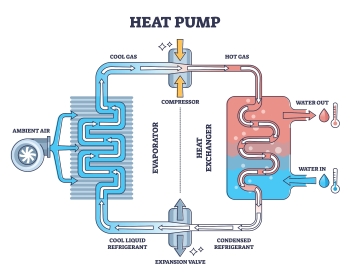As the world continues to make strides towards a more sustainable future, the search for energy-efficient heating solutions and domestic hot water solutions becomes increasingly important. In this guide to air source heat pumps, we delve into the world of commercial air-source heat pumps, shedding light on how they work, and common misconceptions.
Harnessing the power of nature, air source heat pump heaters draw warmth from the outside air, even in colder temperatures, to provide efficient heating. By transferring this heat indoors, they effectively warm your space or domestic hot water whilst reducing your carbon footprint.
Join us as we uncover the inner workings and advantages of air source heat pumps, helping you make an informed decision for your next retrofit or new build project. Check out the Rinnai range of commercial air source heat pumps here Commercial Heat Pump Technology :: Rinnai UK (rinnai-uk.co.uk)
Advantages of Air Source Heat Pump Heating
Air source heat pump heaters operate on a simple principle. They use a refrigerant cycle to extract heat energy from the outside air and transfer it to the inside space. This process is made possible by a combination of four main components: the evaporator, compressor, condenser, and expansion valve.
Firstly, the evaporator absorbs heat from the outside air, which is then transferred to the refrigerant. The refrigerant, in its gaseous state, is then compressed by the compressor, increasing its temperature and pressure. Finally, the refrigerant is expanded through the expansion valve, reducing its temperature and pressure, and the cycle begins again.
This continuous process allows air source heat pump heaters to provide a consistent and efficient source of heating for your project. They can extract heat from the air even in low temperatures, making them suitable for colder climates however be aware that performance will reduce with cooler ambient. The heat generated by air source heat pumps is distributed via a heating system, such as underfloor heating or radiators.
Installing Commercial Air Source Heat Pumps
Installing an air source heat pump requires careful planning and professional expertise. Here are some key aspects to consider during the installation process:
1. Site Assessment: A site assessment is crucial to determine the suitability of your building for an air source heat pump heater. Factors such as available space, outdoor noise levels, and access to electricity will be evaluated. Additionally, the insulation levels and heat demand of your building envelope will be assessed to ensure optimal performance and energy efficiency.
2. System Sizing: Proper system sizing is essential to ensure that your air source heat pump heater meets the heating demands of your project. The calculation of the heating or hot water load requirements will be based on factors such as the size of your project, insulation levels, local weather conditions, heating and domestic hot water demand. Oversized or undersized systems can lead to reduced efficiency and performance issues.
3. Maintenance: Air source heat pump heaters require regular maintenance to ensure optimal performance and longevity. This includes periodic filter cleaning, checking refrigerant levels, inspecting electrical connections, and lubricating moving parts. It's recommended to schedule annual maintenance visits with a qualified technician to keep your system running smoothly.
Common Misconceptions with Commercial Air Source Heat Pumps
Despite their numerous benefits, air source heat pump heaters are sometimes subject to misconceptions and misunderstandings. Let's address some common misconceptions.
1. Ineffectiveness in Cold Climates
One of the most prevalent misconceptions is that commercial air source heat pumps are ineffective in cold climates. While it's true that their performance may decrease as temperatures drop for example at -5 degrees you can could expect a COP of around 2.0 whereas at 15 degrees you could see a COP of around 3.5. modern air source heat pump heaters can still extract heat from the air even in sub-zero conditions. Advances in technology, such as defrost cycles and enhanced refrigerant formulations, have significantly improved their cold weather performance.
2. Noise Levels
Another misconception is that air source heat pump heaters are noisy. While earlier models may have been louder, modern units are designed to operate quietly, The Rinnai range of air source heat pumps come in super silenced models. Check them out here rinnai-uk.co.uk/application/files/4816/5530/2427/Rinnai_Heat_Pump_Brochure_V2.pdf
3. Limited Compatibility
Another misconception is that air source heat pump heaters are limited in terms of compatibility with existing heating systems. Air source heat pump heaters can integrate with a wide range of heating systems and hot water systems including underfloor heating, radiators, and DHW systems.
4. Commercial heat pumps are not a like for like replacement to commercial boilers and the aforementioned site assessment should be carried out for all retrofit works.
We recognise that air source heat pump design is not a straightforward task especially when designing commercial heat pump systems, so we aim to take the pain out of the process with our design support, capital expenditure, operational expenditure and carbon modelling for a free consultation with our heat pump experts contact us today on 0300 373 0660 or Help me choose a product :: Rinnai UK (rinnai-uk.co.uk)
Useful resources
Commercial Heat Pump Technology :: Rinnai UK (rinnai-uk.co.uk)
